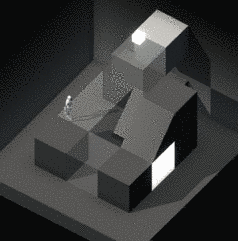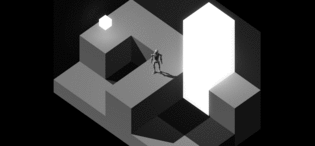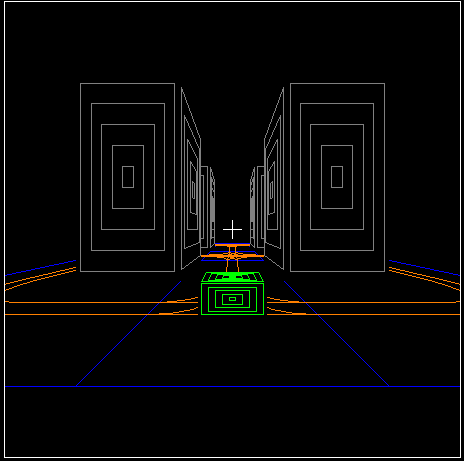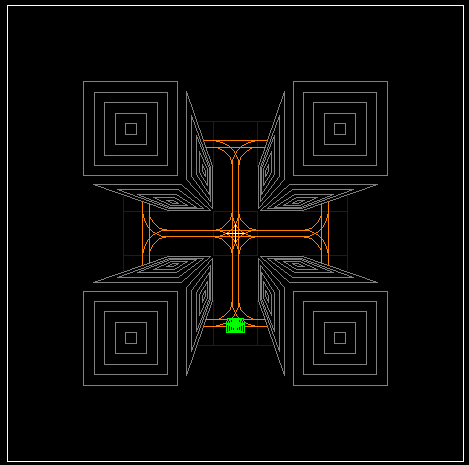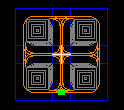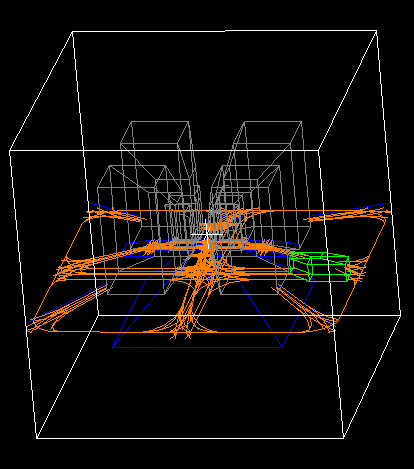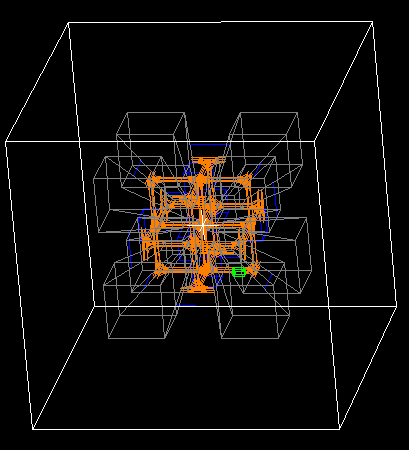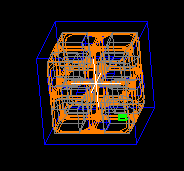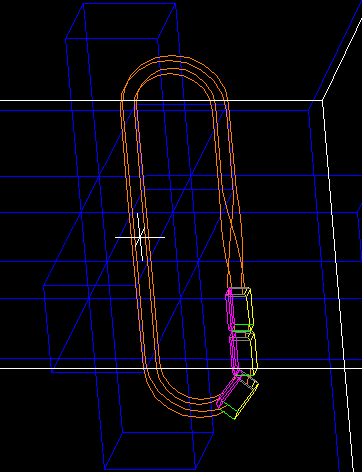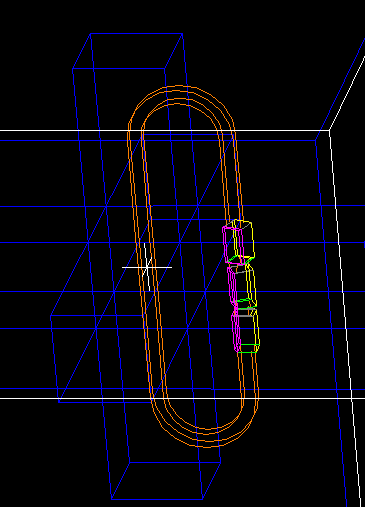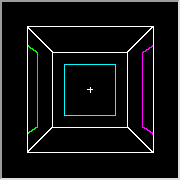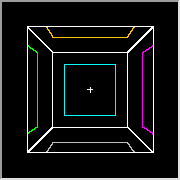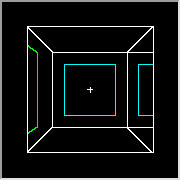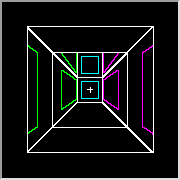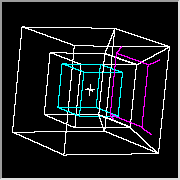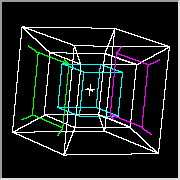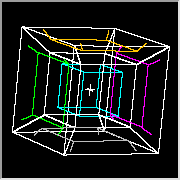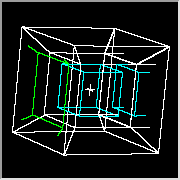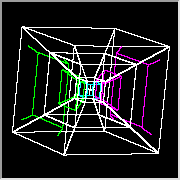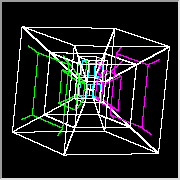Four-Dimensional Games I've Played
(September 2023 update: Added 4DGolf and 4DMiner)
(January-June 2025 update: Added 4D Games, Moena and HoxelDraw)
To further experience the “feeling” of four-dimensional space, creating an interactive program on a computer is ideal. I once dreamed of playing complex 4D modeling software like 3ds Max (unfortunately, it doesn’t exist). Here I’ll organize the four-dimensional programs I’ve played (not necessarily all games) and give some subjective reviews.
Miegakure & 4D Toys
The recently popular game in society, “Miegakure“, is still in development. The game trailer claims to be the first mathematically true 4D game in history, but presents it through the relatively abstract cross-sectional method, with cross-sections chosen perpendicular to the ground. The game renders using tetrahedral cells as basic objects, like triangles in 3D graphics. The trailer shows not only regular hypercuboid room walls, but also 3D ground textures, dodecahedral prism and pyramid combinations, and even four-dimensional trees. Unfortunately, the author has only released a few demos on YouTube, and it’s unclear how long development will take.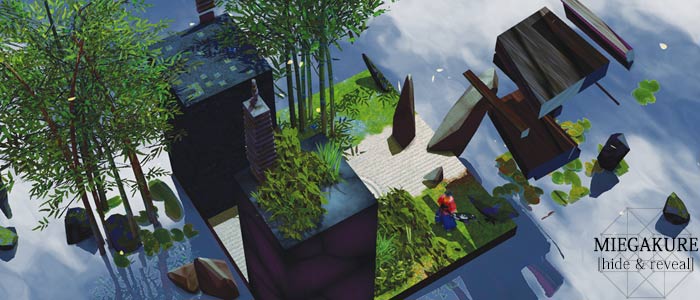
I think the modeling is quite consistent with my “four-dimensional worldview,” but the shortcomings are: first, the cross-sectional method is rather hard to understand, and second, I’m not sure if the flexibility and freedom of view operations can truly let me “freely” experience the spatial sense of four dimensions. Because the author of this game also developed another game “4D Toys“ (pirated versions can be found online), the highlight of this game is its 4D physics engine! You can control hyperspheres to mutually colide with each other, build 4D blocks, and even play with hypersphere beads strung on Hopf tori. Of course, the author still uses the cross-sectional method. But my experience with view operation flexibility was extremely poor: I couldn’t freely choose cross-section directions, all I could do was move my cross-section back and forth, unable to give me a comprehensive four-dimensional spatial sense (it seems the author later updated to add cross-section rotation functionality). Worth mentioning is that “4D Toys” includes all regular polytopes, and even the two types of tori we previously discussed. I discovered from this game that one type of torus link is named “tiger” (a beast to understand like a tiger? Actually taken from the Japanese English pronunciation of “tora”), and this name seems to be officially universal, as I later found descriptions of them on the website higherspace.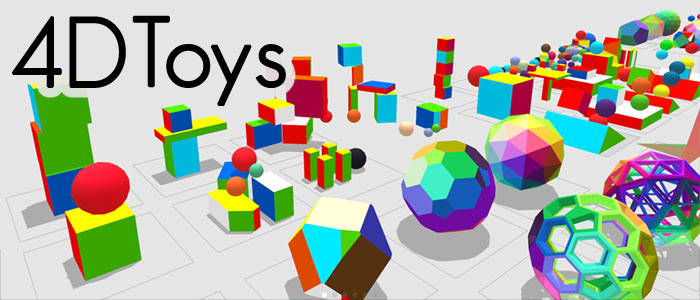
4D Miner
2023 Update 1:
Mashpoe created 4dMiner modeled after Minecraft. Worth mentioning is that my previously written Minecraft4D (2020) was actually much earlier than his (2022), so mine should be the world’s first 4D Minecraft! (Although it’s only a demo) I didn’t discover the existence of 4DMiner until early 2023.
This game uses first-person cross-sectional method for operation, and the cross-section can only rotate around the z-axis, meaning the cross-section is always perpendicular to the ground. The success of this game is that it attracted a considerable player community, but the gaming community over-exploits the properties of four-dimensional cross-sections, such as many creating secret rooms by making entrances very small, then only specific cross-section positions can cut to that entrance to enter. Some even treat this as parallel worlds, building three-dimensional structures layer by layer, using cross-section rotation only as a bridge to different parallel worlds… Very few players in the community can understand the overall isotropic property of the four-dimensional world. Many player buildings probably can’t be seen in voxel photos. But some players have developed mods that support voxel vision with “holographic projection” views! However, the author says this is too performance-intensive and doesn’t want to use it in the game… This is indeed realistic.
Finally, I want to complain about two points: first, his block texture color scheme is very gloomy, making the main world look like the Nether; second, the game’s art promotion features a nonsensical miner wearing “4D glasses” with a third eye like Erlang Shen (A character with 3 eyes in Chinese ancient myth) to see beyond cross-sections, seeming that the author completely doesn’t understand how 4D eyes work… (later we’ll see why he did this)the imaging principles of four-dimensional human eyes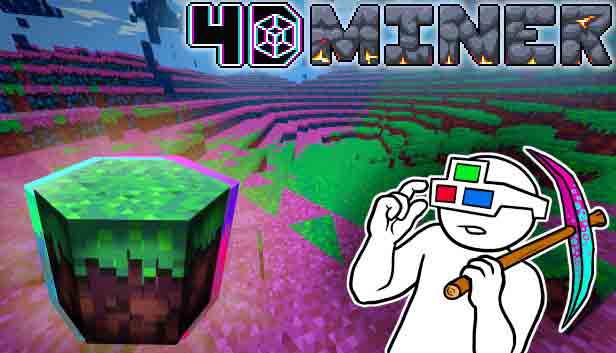
In November 2023, Mashpoe updated a video saying 4DMiner supports multiplayer! The player skins are 3D and highly customizable, but unfortunately, player models are actually just three-dimensional “paper people” in the 4D world. Everyone draws textures of two-dimensional characters, including internal organs and bones. This explains why the author made Erlang Shen’s three eyes - he designed the game world where people aren’t actually 4D beings but 3D ones. These 3D people in the four-dimensional world are actually thickness-less sheets, which is very “unrealistic” and doesn’t conform to my four-dimensional world rule. Of course, overall I still affirm this game. They even built the first 4DMiner autonomous server 4D4T, clearly imitating Minecraft’s 2B2T.
4D Golf
2023 Update 2:
YouTuber CodeParade created a 4D Golf game. From the game’s trailer, it’s the only game supporting arbitrary cross-section rotation, especially being able to rotate vertical cross-sections to horizontal, letting you experience that space-floating weightless feeling on 3D ground. It can also display shadows from other adjacent cross-sections, somewhat approaching the meaning of voxel photos. The game’s levels use wave function collapse algorithms for procedural generation, and there’s also a terrain editor for manually editing 3D maps (see this YouTube video). Whether the specific gameplay will be monotonous remains to be seen (2025 post-play update: I found the level designs are all very thoughtful, even including a speed-based marble mode besides golf, and even several true five-dimensional golf scenarios). His other game Hyperbolica in hyperbolic space, while mathematically rich, I think has poor gameplay. But I want to say, although 4DMiner’s playability should far exceed 4D Golf, the 4D Golf author’s understanding of four-dimensional space is superior to 4DMiner’s. Overall, I think this is an excellent four-dimensional game.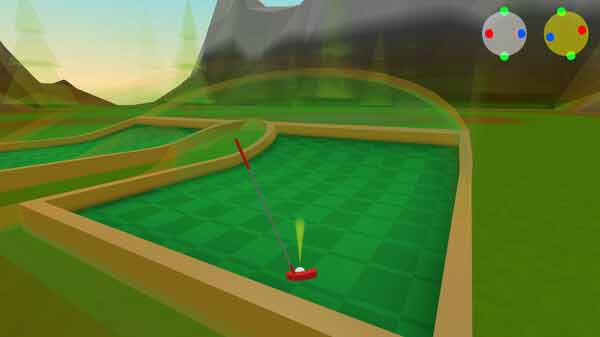
In November 2023, when the author updated about 4D creation, he mentioned that when making grass 3D textures, he first generated many rod-shaped objects randomly filling the 3D area, but cross-sections often resulted in point-like particles that no longer looked like grass. Finally, he changed to using planar textured 2D grass graphics, successfully making cross-sections in all directions appear as linear graphics. I actually want to complain: although this is good for game players, in fact “real” 4D grass should be linear, and cross-sections should be point-like particles. Changing textures to cater to 3D people’s habits is somewhat like cutting feet to fit shoes. Of course, for mass player acceptability, compromise might be necessary.
Games I found in 2025
2025 Update 1:
4D Games on Steam is a game that includes cross-sectional display for manipulating shapes like 4dToys (with duocylinders, torus links, and various polytopes), 4D chess, and 4D maze. Actually, these contents aren’t particularly fresh gameplay. 4D chess also uses stacked 2D chessboards for display, lacking true 4D spatial sense. The 4D maze is a layered 3D pipe-type maze, also completely lacking 4D spatial sence. But the game has an interesting 4D shape editor: you can combine desired four-dimensional shapes through nodes and share them with others. Hint: These four-dimensional graphics’ cross-section calculations actually run ray tracing on the GPU. 
2025 Update 2:
Moena on itch.io is a game that includes 4D galaxy (N-body problem solving) simulation, 4D flight simulation, and even a Minecraft4D-like game:
- The 4D flight simulator is somewhat like the flight simulator on my Tesserxel, both training runway landings. There’s a demo video on YouTube.
- Its 4D galaxy simulation’s gravity still seems to use inverse square law… so no galaxy instability issues appear.
- The author said that after making a Minecraft4D-like game, he discovered that the so-called latest original ideas in Mashpoe’s 4DMiner he had already thought of long ago (I also made Minecraft4D…).
2025 Update 3:
A 4D hypervoxel editor HoxelDraw (Hoxel meaning Hyper Voxel) still in initial prototype development stage, benchmarked against 3D voxel editors like Magica Voxel. Here’s the YouTube introduction video. It still uses cross-sectional method for visualization, but besides normal 3D cross-sections, there’s also a 2D cross-section grid format, similar to 2048 4D that transforms 4D graphics into nested dual two-dimensional coordinates, fully reflecting that 4D space is the direct product of two two-dimensional spaces.
Tetra Space
There’s also a game inspired by “Miegakure” called “Tetra Space“, which also uses cross-sectional display. This game is divided into many levels, each level’s task is to reach a designated clearance point. You need to find paths like navigating a maze, with hypercube blocks that can be pushed on 3D ground, lasers, etc. What I find insufficient is that cross-section orientation can only switch between two directions, and I found that as long as I draw a “floor plan” (actually a 3D map), obstacles are clearly visible on the 3D map, and I can quickly plan routes. Some levels purely take flat maps (ab11) and use cross-sections to cut them into lines (a1*1), so I don’t even need to draw 3D maps. So this game actually doesn’t give me a good four-dimensional spatial sense experience, but purely from gameplay experience, it’s still very good.
|
|
|
4D Block
Finally, I want to mention a game that looks somewhat ugly and might be completely bewildering on first play: 4dBlock (download link), but it’s truly the way four-dimensional beings perceive in my mind. It’s based on perspective principles, projecting 4D graphics onto a 3D “retina” (actually just a normal 3D display area). Of course, 4D perspective projection isn’t rare, but what’s most impressive is its ability to cull some parts to achieve correct front-to-back occlusion relationships for four-dimensional objects! I once thought about analogizing 3D rasterization rendering technology, rasterizing tetrahedral units in three-dimensional grids, then recording depth buffers and doing occlusion culling. However, this software only achieves detection and culling for line segments, so the entire view is wireframe display mode, and a bunch of lines looks like a mess. Actually, as three-dimensional beings who can only see secondary projections, we don’t have the fortune to see this kind of rasterized 3D projection, because in complex scenes if displayed in “solid” mode, we wouldn’t see anything inside. So wireframe display is necessary. Fortunately, this software provides left and right eye views, allowing “cross-eyed” viewing (another barrier) to see three-dimensional stereoscopic sense, somewhat recovering one dimension. This game has built-in four-dimensional mazes (super confusing, at first every frame I had to analogize with three dimensions to understand what happened, every action too), but I think for first-time players, it’s really not very friendly: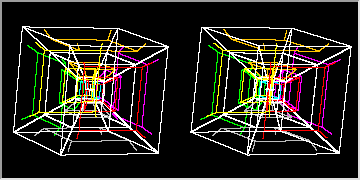
Of course, we shouldn’t be scared by these lines. First try looking at simple things, and through analogy from three dimensions, you’ll gradually experience four-dimensional vision! For example, the road model below: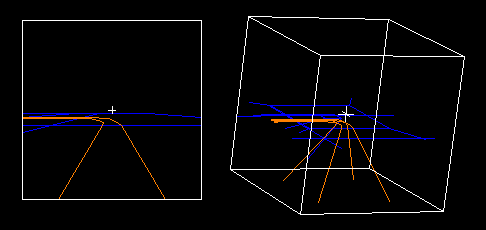
The 4D little train inside is also a highlight. You can control train movement, it has carriages, and in some scenes the carriages even have windows (3D windows on 4D carriages!). There are also more complex roads that are still easy to understand through 3D analogy:
|
|
|
The railway tracks in this game also support a unique “spin” track with no three-dimensional analogy, which I’m very satisfied with.
|
|
|
Note that this kind of spin is essentially like rotating tracks on roller coasters in 3D world amusement parks, but in the 4D world, this rotation can avoid involving the gravity direction, meaning carriages don’t “flip over” - people inside just feel they’ve changed “orientation” and can always sit comfortably in their seats.
The software’s operation is also very flexible, with both translation and rotation, 90° and grid alignment modes (Enter key to align), and free mode where you can tilt however you want. This game truly made me feel one step closer to the 4D world, but there’s no real physics or gravity here. This game’s key bindings are also somewhat strange: forward/backward correspond to keyboard E/D, left/right turning correspond to J/L, up/down turning (looking up/down) I/K, the additional “ana”/“kata” turning unique to four dimensions (they’re similar to left/right turning) correspond to U/O. Holding Alt key plus these direction keys allows movement in specified directions, holding Shift key allows only rotating the 3D projection that the “retina” presents (finally familiar 3D rotation). X/C/V are used to control train movement… The game also has collision detection, not allowing you to pass through objects (otherwise, 4D maze walls would be meaningless). It seems you can also select and move objects, edit scene files yourself, which I haven’t explored yet.
After knowing basic operations, you can navigate mazes. Let’s look at some analogies in four-dimensional mazes: (Four-dimensional mazes aren’t as hard as imagined. You don’t need four-dimensional “directional sense” - I wandered around inside for a while and found the endpoint.)
|
|
|
Other Games
Finally, I want to say, if we combined 4dToy’s physics engine with 4dBlock’s display method, it would be perfect. This game is open source, I want to analyze the source code and try porting a web version to make a 4D racing game (of course just an idea, because actually doing it would be quite difficult).
The reason I spent so much space introducing block4d is mainly because too few people know about it, and understanding it has certain difficulty. For well-known, established 4D programs, I’ll just briefly introduce them here, because there’s too much about them online, so I won’t elaborate:
First is a master’s 4D polytope screensaver program, with source code and geometric data for the 120-cell and 600-cell (unfortunately his data storage cloud drive is down). Here’s the link
Then there’s the well-known Jenn3D polytope browser, which can be called standard equipment for four-dimensional space enthusiasts. It also comes with a Go game on the 120-cell called jenn go. (Every time I play for a while it goes white screen, probably a bug)
Another well-known one is the 4D Rubik’s cube simulator magic4d, but I’m not very good at it because I find it hard to locate blocks and the controls aren’t very familiar.
Other interesting 4D games include 2048 4D (I completed it!), but it’s not closely related to the “spatial sense” I’m looking for. The 4D Geometry forum has collected many 4D game resources. I just discovered that Wikipedia actually has a List of four-dimensional games entry, though some don’t have download links.
2023 update supplement: Finally, I want to promote my own Tesserxel project: it uses voxel rendering while also supporting display of cross-sections from various angles, using multiple approaches to help you perceive the four-dimensional world. It currently has developed a rigid body physics engine, just missing a real game…
